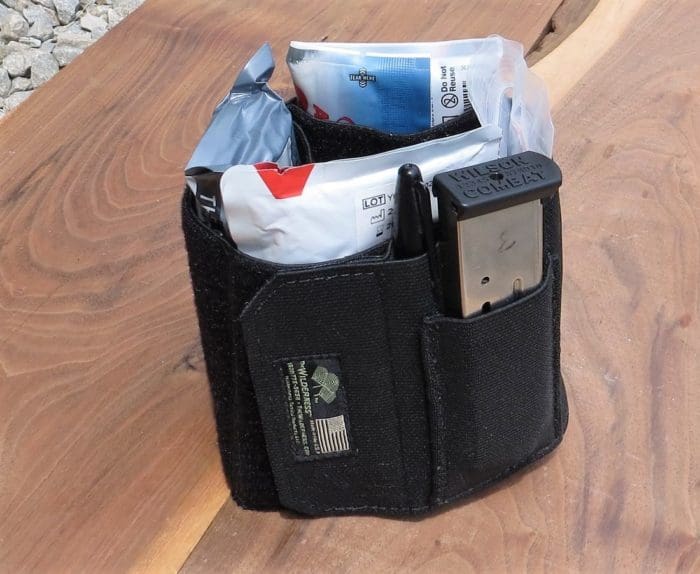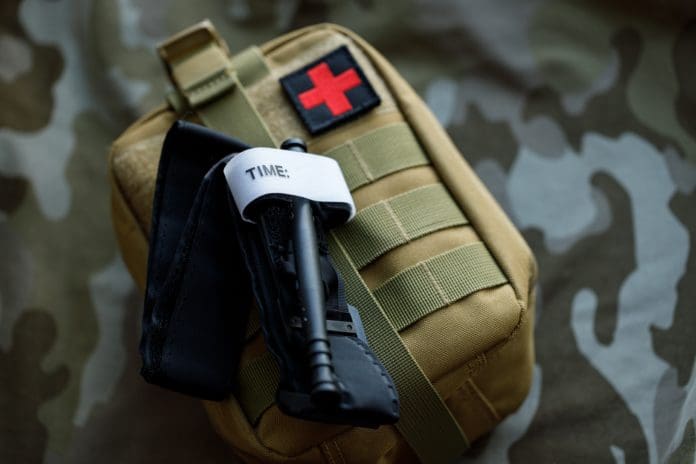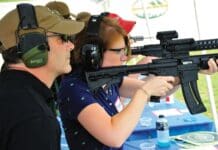By Ryan Cleckner
The goal of a gunfight is not to kill or disable the other person(s), it’s to stop the attack and keep yourself (and anyone else you choose) alive if needed, go back and read that again.
Yes, in order to keep yourself alive and (hopefully) uninjured, you may need to kill or disable an attacker. However, the killing or disabling of the “bad guy(s)” is a means to an end – it’s one method to achieve the ultimate goal of keeping yourself (and anyone else you choose) alive and unharmed. Another method might be running away to safety.
This is an important distinction.
First, it emphasizes the point of self defense; you aren’t trying to kill or disable anyone. You’re trying to defend yourself and others. Second, I believe that too many people train for a gunfight by focusing only on offense and not enough about defense.
If I haven’t lost you already…hear me out.
You will have survived and/or won a gunfight not by killing or disabling the “bad guy(s)” but, rather by being alive. Killing the “bad guy” is irrelevant to the outcome. For example, you may have killed the “bad guy(s)” and still not have won the gunfight if you end up dead as well.
Yes, it’s vitally important to train with a firearm. You must know how to use it and use it effectively to defend yourself and others. You should also be training to get to/fire from as safe a position as possible.
If you were preparing for a football game, would you only focus on offense by only practicing how to score touchdowns? No, you’d practice defense too. You should start thinking about your training the same way.
I encourage you to seek out defensive training. How to defend against a “bad guy” (by running, barricading, etc.). How to prevent the “bad guy” from getting into good position while you’re in a bad one (situational awareness, making good choices, etc.).
But primarily, you should be training to keep yourself and others alive. Putting five bullet holes into a bad guy and killing him is likely little consolation if you’re lying there with four bullet holes in your body and bleeding out. Which brings us to first aid.
If you have a quality firearm and ammunition with which you regularly train, that’s great. If you carry it regularly, even better.
Now, do you have first aid supplies or training? Do you own a tourniquet? Gauze? A chest seal?

In a situation like the horrific Las Vegas shooting, the vast majority of the injured people didn’t have a firearm. They were listening to music in a designated gun-free zone. Therefore no amount of firearms training or tactical skill would’ve helped. However, a small emergency medical kit and the knowledge how to use it would’ve been priceless.
Even without a kit, some knowledge would have helped. Even a granola bar wrapper makes a fine field-expedient chest seal. A belt can be used as a makeshift tourniquet. In the military, we kept giant safety pins handy. In the absence of a proper airway device, I’d have no complaint if someone safety-pinned my tongue to the side of my cheek to keep me breathing and alive.
Of course, I’m stepping way outside of the bounds of “approved” medical treatment here. However, during a mass casualty situation like the Las Vegas shooting, I couldn’t care less what’s “approved.”
I spent my time in the military was with 1st Ranger Battalion/75th Ranger Regiment. When I was in, great effort was made to have an EMT in every functional group. I was a sniper team leader (group of two) and therefore, my unit paid for me to attend civilian training for and become certified as a nationally registered EMT-I.
During our training, we were constantly reminded what we were allowed to do when we were working in an ambulance or the emergency room of the local hospital vs. what we could do on a battlefield where lawyers aren’t a consideration.

Unfortunately, we need to treat some situations such as what happened in Las Vegas like a battlefield when it comes to saving lives (see safety pin comment above). The only consideration then is to mitigate the damage done with anything and everything at hand.
When some gun owners are asked about home defense with a firearm they turn the tables an ask the questioner if they have a fire extinguisher or a burglar alarm. I’d like to piggyback on that: the next time someone tells me about the firearm they have or the training they’ve completed, I’m going to ask them about the first aid (defensive) training they’ve completed or what tourniquet/chest seal they have with them.
I hope this gives you something to consider. Practicing for offense is great. However, you win/survive a gunfight by staying alive, not necessarily by killing the bad guy.
Ryan Cleckner was a special operations sniper team leader in the US Army’s 1st Ranger Bn (75th) with multiple combat deployments and a sniper instructor. He has a series of basic online instructional videos, he’s the best selling author of the Long Range Shooting Handbook, and he’s a firearms industry executive and attorney at RocketFFL.com where he helps folks get an FFL and RocketCCW.com where he qualifies folks for a CCW in over half the country all online.





Exactly!
I have a good friend who sometimes legally carries a gat. He tells me ” I don’t want to kill anyone”. I don’t either but if you’re serious about self-defense it may come to that! Since he’s old(71)I can’t make him “get it”. Not everyone can be redeemed…
I don’t want to kill anyone either. That decision will be up to the attacker. My mind is already made up to survive.
Well said Darkman. And fair.
I am a student and I do work part time on this website to meet my needs. One who is jobless or want to earn more money for himself, (buc-49) should try this because this is really very easy and less time consuming and also advantageous
without investing any amount.. https://richzone99.blogspot.com/
I’m not arguing against first aid. But I would have not needed a kit in Vegas because I do not go to venues like that. Universally the entertainment industry has turned against us and our rights. They do not get a penny from me.
DITTO.
Yep – lookup STUPID PLACES and Vegas leads ANY list.
In the founding of Lost Wages – I mean Las Vegas – a couple of mafia gangs were involved from the beginning so regardless of how the entertainment industry stood between it’s founding and now, the city has always been against us, and only “for” our money.
Shoot until the threat can not testify in court.
You misspelled testify. It is actually spelled “lie.”
possum.
This you???
https://img.ifunny.co/images/adf831ce38be6dc294ca5a98e4989aa7e379e1298c381de0a3ce374243f2fffa_1.webp
Huh. I did it the old fashioned way. I downloaded the image and texted it to Gadsden, then he sent it to Possum. So far he has not acknowledged his identity in the pic.
You’d think there would be a way to directly post images on this forum, but I’m asking waaaaaaay too much. At least the moderation is intrusive, annoying and illogical.
When those F150’s stepped on your last nerve.
Your attacker doesn’t need to be a live to testify or to lie in court: a great deal of damming evidence is contained in the autopsy of a dead body as presented by the prosecutor.
Remember Taylor DZ?
Vicegrips are made in china. If you work with your hands and need a locking plier look at Malco Eagle Grip LP10WC. Made in America and superior in every way to Vicegrips.
That’s me
I am extremely interested in a very small and minimalist trauma kit with not much more than some quick-clotting powder, a tourniquet, and maybe a chest seal. Such a kit should be pretty inexpensive (and the quick-clotting powder would probably dominate the cost of the kit since a tourniquet and chest seal cost pennies to manufacture).
Anyone have any links to such minimalist trauma kits?
Note:
I am not interested in generic “first aid” kits or their contents which I can assemble myself with some adhesive bandages, gauze, tape, elastic wraps, alcohol wipes, and the like. Such “first aid” kits are great for minor scrapes and cuts and pretty much useless for serious trauma.
Dark Angel medical
A few options below, I believe they’re two of the biggest tourniquet/trauma manufacturers, many kits available though most with quik clot gauze instead of powder.
https://www.narescue.com/
https://tacmedsolutions.com/
An ER nurse recently told me that ER’s and trauma surgeons much prefer the use of quick clot gauze over quick clot powder – for medical reasons.
https://tacmedsolutions.com/ for tourniquet that has no plastic.
Problem with “Quikclot” is the shelf life. Expensive and have throw away/replace.
Replacing $50-$100 combat gauze (and cycling the old into training mayerials) every three to four years is expensive?
Most have gone away from the powder to quickclot gauze. Pack the quickclot gauze into the wound, applying consistent pressure. It is important to ensure the chemical makes contact with the source of the bleeding.
Thank you all for the excellent responses and links.
I will be shopping and purchasing something in the near future.
Build your own based on your personal preferences.
Cheaper, less extraneous stuff, cusomizable to location. Once you know what you want to carry you can select the proper container for what you have rather than what someone else built.
I mix them up depending on where they are, which dictates what they contain. My EDC is entirely different than my range kit. The latter is pretty much trauma only in a Raptor IFAK on my belt. The former is more comprehensive in a modified package I can put in any bag I might carry.
The ones in my cars are different still which are different from the household kits which are different from my big bag. All are different from the plain-jane first aid kit in the kitchen.
For example, all my car-kits have multiple burn treatment options because cars catch on fire more often than people do at the range. This is a great place for old HALO seals. I don’t trust them as chest seals anymore but they’ll still do a good burn dressing, just add water. I replace the “post impalement addressing device” with Hyfins these days.
tampons work great for bandaging/ sealing bullet holes.
Ok if have a brain and buy actual med supplies and save the field expedients for your woman.
and you can only carry so many medical supplies with you in your ‘EDC’, enough for you, and maybe sometimes another person but what happens if its you and say two others and you are still able to help then some field expedient might be necessary.
I’m reminded of the supermarket here about 5 years ago. Robber shot three people just right off when he came through the door, the wounds were bleeding-out-very-soon bad. The defender, an ordinary person doing her shopping and was armed, shot the bad guy with her 9mm seven times before he went down. Then the defender ran down some isles and grabbed some sanitary napkin pads and tampons and a couple packs of cleaning cloths from the shelves. Used the cloths to tie together to fashion some tourniquets, applied the pads and the tourniquets and tampons, and saved their lives. Stopped the bad guy, saved those three lives and the other shoppers in harms way, all before the police and paramedics arrived – with her gun, some pads, tampons, and cleaning cloths. All three made it to the hospital and lived.
Sometimes field expedient might be necessary.
This and triage.
I’ve seen someone working on a corpse while another person was bleeding out feet away.
Saving money is NOT the same as saving lives. Get quick clot gauze, not a few inexpensive tampons.
One or the other is often overlooked. A shooter can shoot and maneuver, but can’t stop the bleed and a stop the bleeder can’t shoot and maneuver. Not always of course, but stereotypes are real and all those bumper stickers plus that beer belly plus the way you slid out of that drivers seat tell me that “health” is not the same priority as your NRA donation… Just sayin…
The added benefit of first aid knowledge is that you can possibly save yourself. Again, just sayin… Why not both?
I have looked in my area and not found any basic first aid training that is focused on gunshot or knife wounds, injury trauma etc. I think that’s ironic because I have at least four firearms training opportunities within an hour’s driving distance. We repeat cliches such as “When seconds count….” but don’t include emergency medical treatment/training. The author has a point, we focus on offense, not defense/survival. Mutually assured destruction is not a win.
I recommend TCCC – https://www.naemt.org/education/naemt-tccc
Look at the course directory for training near you – https://www.naemt.org/education/CourseDirectory
From their website, it looks like courses in my area are few, and I can’t take the TCCC course anyway, since it is not open to the public. Maybe only for people who are EMTs already?
I tell this to my students. Your goal is not to hurt or kill. It is to stop.
This helps to set a foundational ethical mindset that the moment the aggression stops, your right to use deadly physical force ENDS.
It doesn’t matter if its because he goes down or because he turns and runs. Once the aggression ends, you lose all ethical (and in many places legal) justification to use force.
I’ve never understood why either part of this is an arguement but both have been for years.
You’re not out to do anything other than get the person you’re shooting at to stop doing whatever it was that caused you to shoot in the first place. If you miss and they stop, good ’nuff.
Medical’s a losing battle IME. People don’t want to carry “stuff” and will bring up strawman arguments instead of just admitting that they’re lazy and don’t want to carry stuff.
7″x7″x2.5″ and 1.48lbs will get you a serious trauma kit plus first aid plus more in a hard-backed zip pouch that holds everything in place until you use it. Everything from gloves and two TQs to chest seals to combat gauze to aspirin and tweezers. Strip out what you don’t want and it gets lighter.
Mention that and most comments contain the word “murse”.
Some ….EDC (and larger) Medical Kits/supplies:
https://www.amazon.com/American-Rescue-Medics-Retractable-Shears/dp/B08BF5DG9R?crid=NWMKO0331QY8&keywords=North+American+Rescue+Squad+Medics+Kit&qid=1657753233&sprefix=north+american+rescue+squad+medics+kit,aps,89&sr=8-5&linkCode=sl1&tag=pewpewtac-20&linkId=a0aac03327d50c0ad7152f6fbbfac03e&language=en_US&ref_=as_li_ss_tl
QuikClot EMS Rolled Gauze > https://medicalgearoutfitters.com/products/quikclot-ems-rolled-gauze?_pos=2&_sid=85f5248c9&_ss=r&aff=119
HyFin Vent COMPACT Chest Seal > https://medicalgearoutfitters.com/products/hyfin-vent-compact-chest-seal-twin-pack?_pos=2&_sid=2f61014e4&_ss=r&aff=119
https://www.mountainmanmedical.com/ > good for complete kits and supplies
https://darkangelmedical.com/ > good for complete kits and supplies
tons of other places too… recommend you have a more complete larger kit in the car and one smaller one for carry if you choose to do that.
What you want to put together is an IFAK, not a basic first aid kit. An IFAK is a First Aid kit technically. Generally, a basic first aid kit is a dinky little kit designed for bumps, bruises, and small cuts. An IFAK is designed to care of those bumps and bruises too, but its real focus is a traumatic injury (e.g. gun shot). IFAK stands for ‘Individual First Aid Kit’ and is something smaller and easily portable like an EDC thing and can consist of the basic necessities like, for example, a tourniquet, chest seal, some gauze, tape. The “Individual” in IFAK doesn’t just mean you, it meas “a individual” as in another person too.
Has some decent ‘more complete’ IFAK and supplies > https://tacmedsolutions.com/collections/trauma-ifak-medic-mass-casualty-kits/ifak-(treats-1)
My other post with a lot more info is in ‘moderation jail’ as I post this one, but to add…
Blue Force Gear has some Trauma kits for carry in various sizes and some supplies > https://www.blueforcegear.com/trauma-kits.html
If you can’t get to a course for trauma type aid – at a minimum have CPR knowledge and take the on line ‘Stop The Bleed’ course at > https://www.stopthebleed.org/training/online-course/
(note: The ‘Stop The Bleed’ initiative is Administered by the American College of Surgeons on Trauma)
Also try the Red Cross courses.
You can find other courses (possibly) near you at > https://www.naemt.org/education/CourseDirectory
‘First Care Provider’ provides free online courses at > https://www.firstcareprovider.com/
‘North American Rescue Enhanced Bleeding Control’ (caters to civilians with little to no advanced medical training) > https://nartraining.com/aha_naemt_certs/enhanced-bleeding-control/
If you happen to live in New Hampshire or are willing to travel there :::: ‘Sig Sauer Bullets & Bandages I & II’ > yes, that Sig Sauer – offers a good immediate basic trauma care course with their shooting stuff – intermediate level stuff > https://www.sigsaueracademy.com/productdisplay/bullets-and-bandages-i > the ‘intermediate’ means students should understand how to safely handle firearms, apply basic marksmanship skills, and draw from a holster, not for the immediate basic trauma care portion. Prior first aid training is not required, they are going to teach you. This is a combined course, sig sauer shooting academy shooting and basic trauma first aid. Its composed of two parts and is a little pricey > $750 for the 3-day Bullets & Bandages I and $500 for the 2-day Bullets & Bandages II. They also have just a Trauma Care portion that does not need firearms and its $310.00 for the one day course > https://www.sigsaueracademy.com/productdisplay/trauma-management. I actually took their Bullets & Bandages I & II courses, good courses, but they are pricey.
One thing that’s always bothered me about every “kit” I’ve ever seen touted is that they all focus on the bells and whistles, and neglect the ONLY truly important things – knowledge and attitude. Having the “best” trauma kit or medical kit in the world does you absolutely no good, unless you have the knowledge to use it, and the stomach to use that knowledge when someone (maybe even yourself) is screaming in pain and bleeding out. Having the kit does not come with that knowledge or attitude.
As others have pointed out above, if you’ve got the knowledge, there are many “field expedient” options that can at least partially make up for the lack of a fancy “kit”, but no kit, no matter how fancy and complete, makes up for not knowing WTF to do with it, or being so panicked you can’t get a bandage on.
That being said, any time I carry (which pretty much is all the time), I carry a first aid/trauma kit that I put together, to suit MY particular knowledge base. Carrying a lot of things, like chest seals and tourniquets, that you don’t know how to use is just silly. Either learn to use it, or remove it from your kit and replace it with something you DO know how to use. If that means that your kit is basically a “boo-boo kit”? Well, as Harry Callahan said, “A man’s got to know his limitations.”
Learn the law (in your area). Then learn the gun. THEN buy a trauma kit.
Comments are closed.